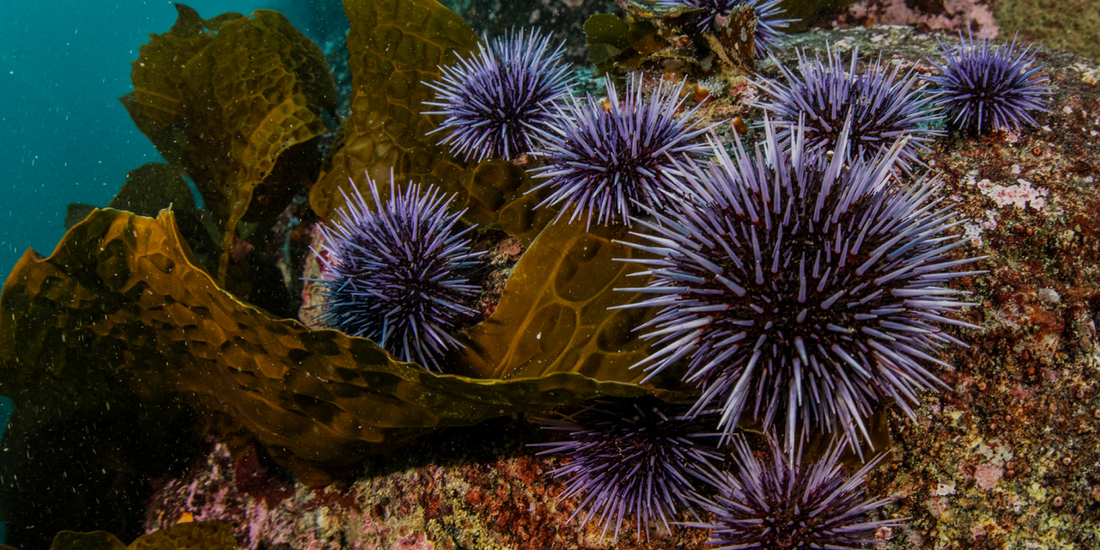Here’s a creature with an even bigger appetite for seaweed than we have: the purple sea urchin (Strongylocentrotus purpuratus). These spiny (and yes, delicious) little grazers have exploded in population over the past decade, devouring vast swaths of vital kelp forest habitat along the Pacific coast. These underwater forests are not just scenic—they’re crucial ecosystems that support an incredible diversity of marine life, from tiny invertebrates to large fish, seabirds, and marine mammals (Smith et al., 2021).
But let’s be clear: purple urchins are not invasive. They’ve been here for millennia and have historically played a balanced role in the ecosystem, serving as a vital food source for predators like sea otters and sunflower sea stars (Harvell et al., 2019). The problem? The natural checks on their population have collapsed. Sea otter populations have been decimated in many areas due to historical hunting and ongoing environmental pressures (Estes et al., 2010), while a catastrophic outbreak of sea star wasting disease has nearly wiped out the sunflower sea star (Pycnopodia helianthoides), one of the urchins’ top predators (Hewson et al., 2014).
With these predators in decline, purple urchins have thrived unchecked, transforming once-lush kelp forests into barren underwater deserts—what scientists now call “urchin barrens.”
So what can we do to restore balance and help save our kelp forests?
Eat more uni!
Humans can step in as ecological allies by harvesting and eating MORE purple urchins. The edible part, known as uni, is considered a delicacy in many cultures—especially in Japanese cuisine. Uni is prized for its rich, creamy texture and its complex flavor: briny, subtly sweet, and deeply umami.
By consuming purple urchins, we’re not just enjoying a sustainable seafood option—we’re actively helping to restore marine ecosystems. Think of it as culinary conservation: your appetite can be a force for ecological good.
Want to learn more? Join us on June 28th for a seaweed and urchin foraging event in collaboration with Maria Finn of Flora & Fungi of Marin!
We’ll explore the intricate relationships between kelp, urchins, and the health of our intertidal ecosystems—and you’ll get a chance to taste the difference stewardship can make.
And it’s not just about urchins—supporting small-scale seaweed mariculture is another powerful step. At Rootless, we source seaweed primarily from sustainable, small-scale farmers across North America. Our Seaweed-Powered Daily Bites are a delicious way to support ocean health and coastal economies. Eating ethically sourced seaweed is not only incredible for your health and well-being, it also drives demand for the responsible growth of the regenerative seaweed industry.
What we eat—and where it comes from—is one of the most immediate, impactful ways we can address climate change and protect fragile ecosystems.
So next time you get the chance, add some uni and seaweed to the menu, or better yet, make seaweed your next nutritional staple!
References:
-
Estes, J.A., et al. (2010). Trophic Downgrading of Planet Earth. Science, 333(6040), 301–306.
-
Harvell, C.D., et al. (2019). Disease epidemic and a marine heat wave are associated with the continental-scale collapse of a pivotal predator (Pycnopodia helianthoides). Science Advances, 5(1), eaau7042.
-
Hewson, I., et al. (2014). Densovirus associated with sea-star wasting disease and mass mortality. Proceedings of the National Academy of Sciences, 111(48), 17278–17283.
- Smith, J.E., et al. (2021). Kelp forest resilience in the face of multiple stressors. Frontiers in Marine Science, 8, 622203.
